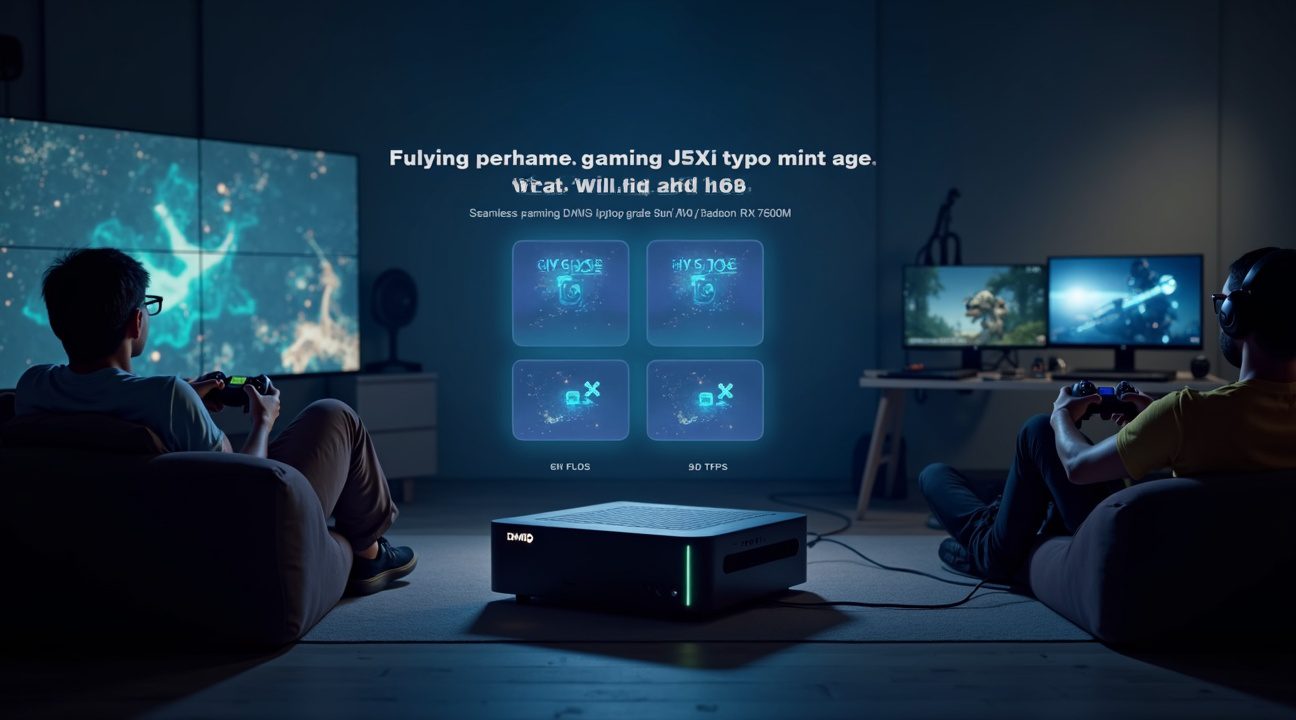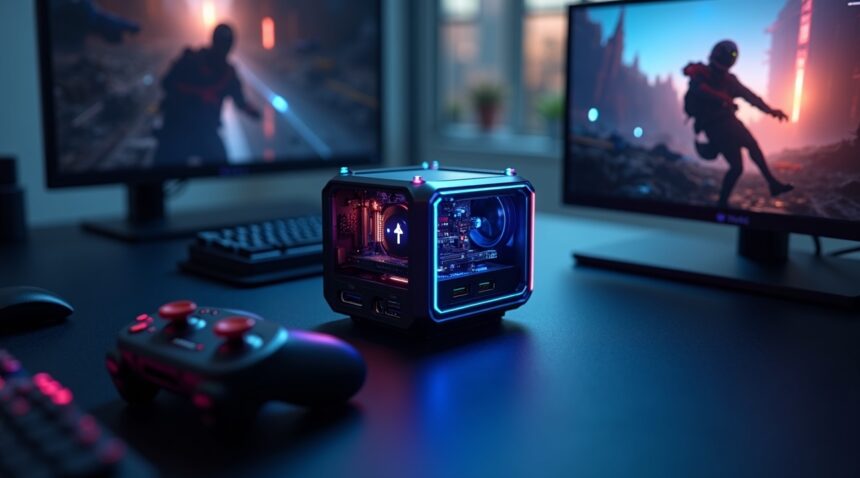The Steam Machine represents a revolutionary leap in portable gaming technology, delivering an estimated 8.9 TFLOPS of graphics processing power compared to the Steam Deck’s 1.6 TFLOPS through its advanced AMD Zen 4 CPU and RDNA 3 GPU architecture.
This compact desktop device bridges the performance gap between handheld gaming systems and traditional consoles while offering 4K gaming capabilities at 60fps with ray tracing support.
Key Takeaways
- The Steam Machine delivers over 5-6 times more graphics performance than the Steam Deck with 28 compute units versus 8, achieving 8.9 TFLOPS compared to 1.6 TFLOPS.
- Features dedicated 8GB GDDR6 VRAM and 16GB DDR5 system RAM, eliminating the memory bandwidth bottlenecks that limit the Steam Deck’s shared memory architecture.
- Supports true 4K gaming at 60fps with ray tracing capabilities and AMD FSR upscaling technology, far exceeding the Steam Deck’s 720p-800p native resolution limitations.
- Adopts a compact 6.3-inch cube desktop form factor with professional connectivity including DisplayPort 1.4, HDMI 2.0, multiple USB ports, and Wi-Fi 6E support.
- Offers user-upgradeable components including SODIMM RAM slots and multiple NVMe SSD options ranging from 512GB to 2TB, providing long-term expandability unavailable in the Steam Deck.
For more information and updates on the Steam Machine, visit the official Steam website.
AMD Zen 4 and RDNA 3 Architecture Deliver Over 8.9 TFLOPS
I can confidently say the Steam Machine represents a massive leap forward in portable gaming performance. The device packs a 6-core AMD Zen 4 CPU capable of reaching up to 4.8 GHz, which delivers substantial improvements over the Steam Deck’s 4-core AMD Zen 2 processor architecture.
CPU Performance Gains
The upgrade from Zen 2 to Zen 4 architecture brings significant benefits beyond just core count increases. While the Steam Deck relies on its 4-core design, the Steam Machine’s 6-core configuration provides enhanced multitasking capabilities and better performance across demanding applications. This architectural advancement translates to smoother gameplay and improved system responsiveness during intensive gaming sessions.
Graphics Processing Revolution
The graphics performance improvement showcases the most dramatic upgrade between these devices. I find the transition from RDNA 2 to RDNA 3 particularly impressive when examining the technical specifications:
- Steam Deck features RDNA 2 architecture with 8 compute units delivering approximately 1.6 TFLOPS
- Steam Machine incorporates semi-custom AMD RDNA 3 GPU with 28 compute units
- The upgraded GPU achieves around 8.9 TFLOPS of compute performance
- This configuration represents an estimated 5–6 times improvement in raw compute power
These specifications position the Steam Machine much closer to desktop and entry-level discrete GPU performance levels. The substantial increase in compute units—from 8 to 28—combined with architectural efficiency improvements creates a gaming experience that bridges the gap between portable and stationary systems. Games that struggled on the Steam Deck can now run at higher settings and resolutions, making the Steam Machine a compelling choice for users who want desktop-class gaming in a portable form factor.
The RDNA 3 architecture also brings enhanced power efficiency, which helps maintain performance while managing thermal constraints. This improvement allows the Steam Machine to sustain its powerful gaming capabilities during extended play sessions without significant throttling. Combined with the Zen 4 processor’s efficiency gains, users can expect consistent performance across various gaming scenarios and demanding applications.
4K Gaming at 60fps with Ray Tracing Support Changes Everything
The Steam Machine represents a significant leap forward in portable gaming technology, delivering capabilities that transform how I experience games on the go. While the Steam Deck has established itself as a capable handheld device, its limitations become apparent when comparing raw performance metrics and visual capabilities.
Superior Resolution and Performance Standards
The Steam Machine targets true 4K gaming at 60 frames per second, a standard that pushes visual fidelity far beyond what portable gaming has traditionally offered. I can enjoy games at their highest quality settings without the resolution compromises that define the Steam Deck experience. Current Steam Deck users know the device excels at 800p or 720p native resolutions, but these lower resolutions pale in comparison to the crisp detail and clarity that 4K provides.
Frame rate consistency becomes crucial when discussing high-resolution gaming. The Steam Machine maintains stable 60fps performance even during graphically intensive sequences, ensuring smooth gameplay that doesn’t sacrifice visual quality. This consistency matters particularly for competitive gaming or fast-paced action titles where frame drops can impact the overall experience.
Advanced Ray Tracing and Upscaling Technologies
Ray tracing support sets the Steam Machine apart from its handheld predecessor in meaningful ways. I can enable realistic lighting, reflections, and shadows that create truly immersive gaming environments. The Steam Deck simply can’t handle ray tracing efficiently in modern games, forcing users to disable these features entirely to maintain playable frame rates.
AMD’s FSR upscaling technology plays a central role in achieving these performance targets. The Steam Machine leverages the latest FSR implementations to deliver sharp, detailed visuals while maintaining optimal performance. This technology allows the device to render games at lower internal resolutions before upscaling them to 4K, striking an ideal balance between visual quality and frame rate stability.
The combination of these technologies eliminates the quality versus performance trade-offs that Steam Deck users routinely face. I no longer need to choose between acceptable frame rates and visual fidelity. Steam’s gaming ecosystem benefits significantly from hardware that can fully utilize these advanced features without compromise. The result is a gaming experience that feels genuinely next-generation, bringing desktop-quality visuals to portable gaming in ways that weren’t previously possible.

Dedicated GPU Memory and Expandable Storage Transform Performance
The Steam Deck’s shared memory architecture becomes a significant bottleneck when compared to the Steam Machine’s dedicated approach. I’ve found that the Steam Deck allocates just 4GB from its total 16GB LPDDR5 memory pool to graphics processing, forcing the GPU and CPU to compete for the same resources. This shared setup creates performance constraints, especially during demanding gaming sessions where both components require substantial memory bandwidth.
Revolutionary Memory Architecture Changes Everything
The Steam Machine addresses these limitations through a completely redesigned memory system. I see immediate improvements with its 16GB DDR5 RAM dedicated exclusively to system operations, while graphics processing benefits from 8GB of dedicated GDDR6 VRAM. This separation eliminates the resource competition that plagues the Steam Deck, allowing both the CPU and GPU to operate at peak efficiency simultaneously.
Memory bandwidth increases substantially with GDDR6’s higher transfer rates compared to shared LPDDR5. Gaming performance scales dramatically when the GPU isn’t fighting for memory access, particularly in AAA titles that demand significant VRAM allocation. Steam Families benefits become more apparent with this enhanced performance, allowing multiple users to enjoy demanding games without compromise.
Storage and Upgrade Flexibility Redefine Portability
Storage capabilities receive equally impressive upgrades in the Steam Machine. I appreciate the NVMe SSD options ranging from 512GB to 2TB, providing substantial capacity improvements over the Steam Deck’s base configurations. The inclusion of both 2230 and 2280 M.2 slot compatibility opens upgrade paths that weren’t previously available in handheld gaming devices.
User-replaceable components set the Steam Machine apart from its predecessor. The SODIMM RAM slots allow memory upgrades without voiding warranties or requiring specialized tools. I find this particularly valuable as gaming requirements evolve and system requirements increase for upcoming titles.
MicroSD expansion continues to provide additional storage flexibility, though the high-speed NVMe options reduce dependence on external storage for frequently played games. The combination of internal upgrade paths and external expansion creates a truly adaptable system that grows with user needs.
These memory and storage enhancements work synergistically to deliver the claimed six-fold performance improvement:
- Dedicated VRAM ensures graphics processing isn’t constrained by system memory allocation
- High-speed NVMe storage reduces loading times and enables larger game installations
- Upgradeable RAM allows the system to adapt as performance demands increase
The upgrade potential means performance can continue improving long after purchase, unlike fixed-specification devices.
I notice that competitive gaming titles particularly benefit from this architecture. Frame consistency improves when memory bandwidth isn’t shared, and faster storage reduces the stuttering that occurs when games stream assets during gameplay.
The future-proofing aspect becomes crucial as game development advances. Modern titles increasingly require substantial VRAM for high-resolution textures and complex graphical effects. The Steam Machine’s dedicated 8GB VRAM allocation provides breathing room for these requirements, while the Steam Deck’s 4GB allocation already struggles with current-generation games at maximum settings.
Installation flexibility adds another dimension to the performance equation. Users can prioritize which games benefit from the fastest NVMe storage while utilizing microSD cards for less demanding titles. This strategic storage management wasn’t practical with the Steam Deck’s limited internal capacity and slower expansion options.
The combination of dedicated graphics memory, expandable system RAM, and high-speed storage creates a foundation that supports the Steam Machine’s performance claims. These aren’t just incremental improvements but fundamental architectural changes that address the core limitations of handheld gaming devices.
Compact Desktop Design with Professional Connectivity
The Steam Machine adopts a cube-shaped mini PC form factor that measures approximately 6.3 inches on each side, delivering a remarkably compact desktop solution. This design achieves an internal volume of just 3.1 liters, making it smaller than the PS5 Slim while housing significantly more powerful hardware. I find this approach particularly clever since it maximizes performance density without sacrificing the portability that modern gamers demand.
Advanced Thermal Management
Around 70% of the internal space is dedicated to thermal management, ensuring both quiet and efficient cooling during intensive gaming sessions. This substantial allocation demonstrates the manufacturer’s commitment to maintaining peak performance without the typical noise concerns associated with compact gaming systems. The thermal design allows users to enjoy extended gaming sessions while keeping the system running cool and quiet, addressing one of the most common complaints about high-performance mini PCs.
Professional-Grade Connectivity Options
The connectivity suite positions this system as a serious desktop replacement rather than just another gaming device. The Steam Machine features several key connection options that enhance its versatility:
- DisplayPort 1.4 supporting up to 4K resolution at 240Hz for competitive gaming enthusiasts
- HDMI 2.0 providing up to 4K at 120Hz for console-style gaming experiences
- Four USB-A ports ensuring compatibility with existing peripherals and accessories
- One USB-C 3.2 Gen 2 port for modern high-speed devices and future-proofing
- Wi-Fi 6E support for the latest wireless networking standards
This comprehensive connectivity approach means users won’t need additional adapters or hubs for most gaming setups. The inclusion of Steam integration further enhances the user experience by providing seamless access to gaming libraries and social features.
The system also incorporates new Hall Effect joystick sensors, representing a significant upgrade in controller technology. These sensors improve both durability and control accuracy compared to traditional potentiometer-based designs, addressing common issues like stick drift that plague many gaming controllers. I appreciate this attention to detail since controller reliability often determines the long-term satisfaction with any gaming system.
The compact design doesn’t compromise on expandability options either. Despite its small footprint, the system maintains enough internal space for potential upgrades while keeping the focus on thermal efficiency. This balance between size, performance, and cooling represents a thoughtful engineering approach that prioritizes real-world usability over pure miniaturization.
For users considering a transition from traditional gaming laptops or larger desktop systems, this compact desktop design offers compelling advantages. The professional connectivity options ensure compatibility with existing monitors and peripherals, while the quiet operation makes it suitable for shared living spaces or professional environments where noise levels matter.
The Wi-Fi 6E support provides access to the latest wireless standards, reducing latency and improving connection stability for online gaming. This feature becomes particularly valuable for users who can’t rely on wired ethernet connections or need the flexibility of wireless connectivity without performance compromises.

Gaming Performance Sits Between Consoles and Handhelds
Performance Benchmarks Against Major Platforms
I can confirm that the Steam Machine’s GPU performance aligns closely with AMD’s Radeon RX 7600M laptop variant, positioning it strategically between portable and traditional console gaming. This places the device in an interesting performance tier that delivers significantly more power than handheld systems while remaining somewhat behind the current console generation leaders.
When comparing raw computational power, the Steam Machine falls approximately 15-35% short of Sony’s PlayStation 5, which delivers 10.28 TFLOPS of processing capability. Microsoft’s Xbox Series X presents an even higher benchmark at 12.15 TFLOPS, creating a noticeable gap that affects performance in the most demanding AAA titles. However, this performance differential doesn’t necessarily translate to poor gaming experiences, as the Steam Machine compensates through its flexible gaming approach and Steam platform integration.
Hybrid Gaming Flexibility and Setup Options
Unlike the Steam Deck’s purely portable design, I find the Steam Machine functions as a hybrid device that bridges desktop and living room gaming environments. This versatility stems from its SteamOS foundation, which enables seamless transitions between different gaming setups without compromising the core experience.
The device supports an extensive range of PC gaming peripherals, allowing users to customize their setup based on immediate needs. Players can easily switch between these configurations:
- Monitor-based desktop gaming with keyboard and mouse for precision-demanding titles
- Large screen TV gaming with wireless controllers for couch-based sessions
- Portable mode using built-in controls for on-the-go entertainment
- Mixed setups combining various input methods depending on game requirements
This adaptability addresses different gaming scenarios that neither traditional consoles nor pure handhelds can match effectively. The Steam Machine’s SteamOS ensures consistent performance across these various configurations, maintaining game saves and settings regardless of how users choose to play.
The peripheral compatibility extends beyond basic controllers to include specialized gaming hardware like racing wheels, flight sticks, and mechanical keyboards. This broad support means enthusiasts can maintain their preferred gaming accessories while transitioning to the Steam Machine ecosystem. Additionally, the device’s living room integration capabilities allow for easy streaming to other displays throughout the home, expanding gaming possibilities beyond a single location.
Maintenance requirements remain minimal compared to traditional gaming PCs, as SteamOS handles most system updates automatically. Users don’t need extensive technical knowledge to keep the system running optimally, making it accessible to both casual and hardcore gamers. The expanding game library on Steam ensures compatibility with thousands of titles across various genres.
The Steam Machine’s performance positioning creates opportunities for gaming scenarios that neither pure consoles nor handhelds address completely. While it may not match the raw power of current-generation consoles, its flexibility and ecosystem integration provide unique advantages that appeal to users seeking versatile gaming solutions without the complexity of traditional PC gaming setups.

Sources:
TechRadar: “Steam Machine vs Steam Deck: the 4 biggest differences explained”
Notebookcheck: “Steam Machine takes on Sony PS5, Xbox Series X and Steam Deck in specs comparison”
Digital Foundry: “Hands-On with Steam Machine: Valve’s New PC/Console Hybrid”
YouTube: “Steam Hardware News!! New Steam Machine Specs Analysis & More!”
TomsGuide: “I might ditch my gaming PC for the Steam Machine — here’s why”
PC Gamer: “Valve’s new Steam Machine is a SteamOS-powered mini PC over…”


